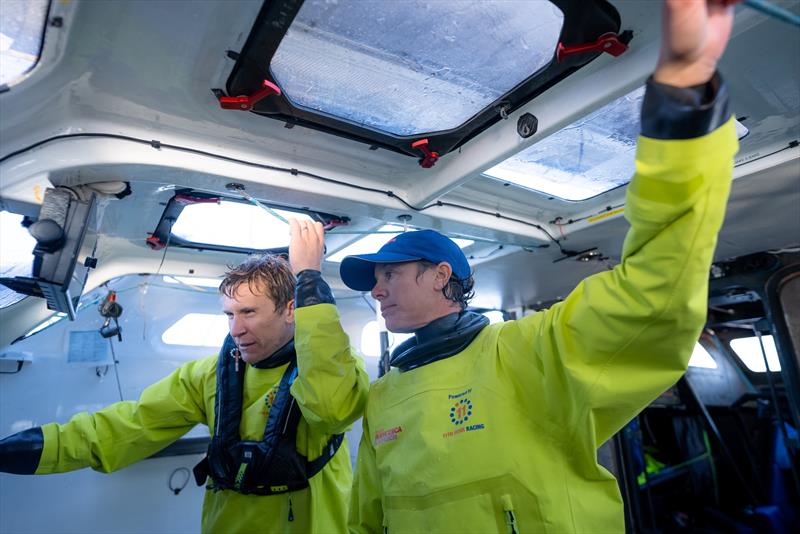
It's time to go racing… countdown to the Transat Café L'OR is on
by Francesca Clapcich 24 Oct 17:44 BST

11th Hour Racing © Marin Le Roux - polaRYSE / 11th Hour Racing
Italian-American professional offshore sailor Francesca Clapcich is set to become the first American woman to take on the notoriously challenging double-handed race, the Transat Café L'OR. Clapcich and her co-skipper, Will Harris (GBR) will cross the startline of the 4,350 nautical mile route from Le Havre, France, to Martinique in the Caribbean, on Sunday, October 26, 2025.
This race will be the first for Clapcich under the colors of Team Francesca Clapcich Powered by 11th Hour Racing, her newly formed offshore sailing team, which has the ambition to see her on the startline of the 2028 Vendée Globe, racing solo, non-stop around the world.
"It's time to go racing and I can't wait!" commented Clapcich. "It's been an intensive build-up over the past two weeks and our 20-strong technical and shore team have been working around the clock to get the boat prepared for our first race. We've rebranded the boat, we've removed excess weight from inside, we've completed a full review of the boat from end to end, all the sails have been checked, and we're now ready to take on the first race under the flag of 11th Hour Racing.
"I can't thank my shore team enough for all the hours they have put in - even sleeping onboard on Wednesday night due to Storm Benjamin to ensure that she was safe! It's down to Will and I now to race as fast as we can and deliver a good result for the team."
The Transat Café L'OR route connects Le Havre, France's leading coffee port since the 17th century, to Fort-de-France, in Martinique, a historic coffee-growing land. There are four Classes of boats competing, with four race courses; Clapcich and Harris are racing in the IMOCA Class - for 60-foot monohulls - the fastest monohulls on the planet.
The duo will leave Le Havre on Sunday on a course that takes them from the Normandy coastal town through the English Channel and down towards the Canary Islands. After passing the Spanish archipelago on their right, the co-skippers must choose between a risky northern route to catch powerful depressions or a calculated southern route to hook into the steady trade winds, until the tricky rounding of Martinique and the finish line. The race is expected to take them 10-14 days.
It promises to be a fast and furious start for the fleet as they leave Le Havre with a north-westerly wind over 20 knots (23mph | 37kmph], which looks to build for the first night.
Every day in the build-up to the start, Clapcich and Harris have met with Marcel van Triest, one of the world's leading navigators and weather routers, and together they review the weather models. Once the duo are under way, they are not allowed any routing or outside assistance, and will only be supplied with weather files sent by the race organization using satellite communications.
"It will be a bumpy ride on Sunday as we head out into the English Channel," said Harris. "One good thing about that is that it gets us out there quickly, but there will potentially be gusts of up to 40 knots [46mph | 74kmph], so our focus will be to keep the boat in one piece. As we move around the island of Ouessant [Ushant] the wind will start to ease a bit and our first challenge will be a light wind ridge that we'll have to pick our way through carefully.
"After that there is a low pressure system which is much further south than normal, towards the Portuguese Coast and that's going to really affect our route south. We will have to choose how we get around the low - do we sail in uncomfortable upwind conditions and take the shorter route or do we try to go a longer route, around the west of it, and sail downwind. We'll have to see what the next few days of weather reports bring."
The team will be carrying with them a Météo France buoy which will be deployed after they have rounded the Canary Islands, and once released will send back data including atmospheric pressure, temperature, and surface current, which will be used by global and regional meteorologists, providing observations used for climate research, ocean monitoring, and forecasting. The second is a smaller 'Argonautica' beacon, which will be kept onboard for both the race to the Caribbean and carried on the delivery back. In a space-inspired education initiative, this beacon sends back data which tracks the boat, sharing information about which satellite the beacon is connected to and data about the area of ocean they are sailing through, to schools and colleges around France.
"When we go racing we often sail in areas that are hard to reach by regular ocean going scientific vessels and so we are really pleased to support the scientific and educational communities by taking the buoy and beacon with us. We have been given co-ordinates by Météo France on where they want the buoy deployed; it's an important contribution as citizen scientists and one I'm really proud to take on," said Clapcich.
And what is in store for the pair for the final 48-hours before the starting gun goes off? "Weather, weather, weather! It doesn't take five minutes doing this - we'll probably spend five or six hours a day looking at the weather." commented Harris. "The goal is to arrive on the dock on Sunday morning with a clear plan of exactly what we're going to do in the first 48-hours. We've done a lot of sailing already together this year, the boat is ready, we know her well, and we trust the preparation the team have put into it. I'm looking forward to getting started," he concluded.